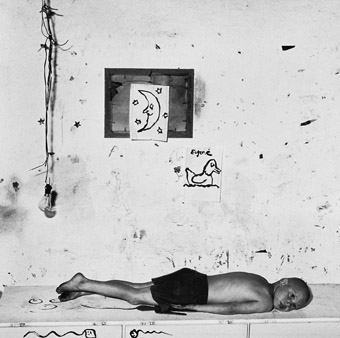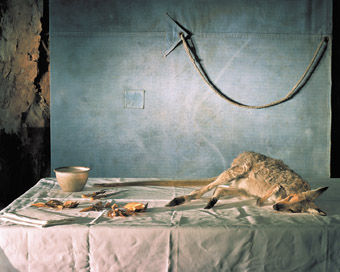dark illuminations
jonathan marshall previews fotofreo 2008

Roger Ballen, Under the Moon
courtesy the artist
Roger Ballen, Under the Moon
NOW IN ITS THIRD INSTALMENT, FOTOFREO IS BRINGING METAPHORICALLY AND LITERALLY DARK PHOTOGRAPHY TO SUN-BLASTED FREMANTLE. THE BIENNIAL FESTIVAL IS CATHOLIC IN ITS PROGRAMMING, REPRESENTING ART PHOTOGRAPHY, FASHION, PHOTOJOURNALISM, LANDSCAPE AND EVEN UNDERSEA PHOTOGRAPHY. NEVERTHELESS, ISSUES OF PLACE AND RACE SNAKE THROUGH THE EXHIBITIONS, WITH QUESTIONS ARISING OF OWNERSHIP (INDIGENOUS RIGHTS, THE PLACE OF WORKING CLASS WHITES IN THE NEW SOUTH AFRICA) AND LANDSCAPE (NOTABLY THE INDUSTRIAL DETRITUS CAPTURED BY EDWARD BURTYNSKY).
A keynote speaker at the Fotofreo Conference, the Canadian Burtynsky is renowned for his industrial landscapes. The large-format foreshore images in his Shipbreaking [2000] series of jagged and curving, rusted steel forms inspired Anna Tregloan’s set design for the Black Swan-Malthouse co-production of The Odyssey for the 2005 Perth International Arts Festival. Solidifying this connection with Australia, Fotofreo has commissioned a work from Burtynsky reponding to Western Australian tailing dumps and minescapes. The artist’s profoundly ambiguous images, tense with an arrested melancholy, will contrast with more familiar WA landscape photography such as Richard Woldendorp’s touristic aerial images of a land of ‘sweeping plains’ and beaches without horizons.
Contemporary indigenous photography is also included with the aggressive historical commentary of Brook Andrew. He is best known for the image Sexy and Dangerous (1996)—a key acquisition when the National Gallery of Victoria’s new Ian Potter Gallery of Australian art opened at Federation Square, and which emblazoned a smooth skinned Aboriginal torso with Japanese text. Andrew has more recently reworked greyed and patinaed anthropological photos of Australian Aboriginals from the early 20th century (Gun Metal Grey, 2007). His current work also includes an explicit challenge to relate the history of Australia and its art to that of the dawn of the European colonial project, late Renaissance and Mannerist painting. In Portraits and Costumes, Andrew has figures dressed in a pastiche of 17th century courtly dress and animal costumes, executing ironic acts of dance and gesture which literally inscribe a space in front of works of ‘the Great Masters’ hanging on walls behind them. This is a challenge both to their greatness, as well as to where one should place Australia and its first peoples within these histories.

Marilyn Drew, Wallaby with Tarp
courtesy the artist
Marilyn Drew, Wallaby with Tarp
An equally formalist approach to these issues is presented by Marion Drew. Drew has represented the Australian landscape both directly, in her dense blobs of Queensland’s jungle suspended in blocks of darkness (2006), and indirectly as in her 2004 commission for Brisbane Magistrates Court, Tankstream (a series of “watergrams” which reference the stream running beneath the site prior to settlement). Drew’s most famous project is her 2005 Australiana series, which recreates Dutch still life in Australia using native animals (roadkill, as it happens) and local settings. As Drew has observed, 17th century still life was rich in allegorical symbolism, but once decoupled from that context, these symbolic references become strangely haunting and ambiguous. Are they cries against settlement, against modernity, or aestheticised portraits of romanticised mortality? Drew likens her photographs to drawings because she produces them using long exposures in a dark environment, “sketching” her subjects using a torch. This generates soft, hyperreal images.
A particular treat for Francophiles is the work of “ar-ctivist, photograffeur” (artist-activist and photographic graffitist) JR, who made his name representing friends from Paris’ economically depressed outer suburbs—the banlieue—inhabited by African and Algerian immigrants from France’s former colonies. Months before les banlieue erupted in riot in 2005, JR posted gargantuan photocopies of his distorted close-ups throughout the city. As he observed, inhabitants of the richer central suburbs “saw the young people from the banlieue as though they were extraterrestrials. I decided to show them like that in my photos!” These massive grimacing visages literally got in the faces of Parisians living close to the centres of power, and similar images were later pasted on Paris City’s prestigious Town Hall, as well as on the barrier separating Israel from Palestine and the West Bank. Now institutionally recognized, JR maintains his anonymity, his commitment to illegal street postings and continues to re-photograph his urban galleries and bewildered, sometimes angry spectators in front of them.
Amidst this rich diversity of Fotofreo exhibitions, a highlight is the work of Roger Ballen who established himself in the 1990s, photographing poor whites from the “dorps” lying on the fringes of Johannesburg. Initially cloaked in the aura of documentary photography, Ballen’s work scandalised audiences with its suggestion of a new, post-Apartheid underclass, as well attracting accusations of exploitation (like Diane Arbus) given his focus on bodily grotesquery and illness. While far from free of such references, Ballen’s material has increasingly emerged as profoundly Surrealist, with key tropes such as human-animal hybrids, graffitied scrawls and potently ambiguous surfaces, scenes and detritus (shades of Marcel Duchamp’s readymades). Ballen’s Puppy Between Feet (1999) reworks Jacques-André Boiffard’s photograph Big Toe, published in 1929 with an essay by dissident Surrealist Georges Bataille. Bataille claimed, “The big toe is the most human part of the body, in the sense that no other element of this body is as differentiated” from that of semi-arboreal apes, the toe’s grotesque corns and grimy protrusions signifying man’s essential connection to dirt, filth and what Bataille called the “baseness” of humanity’s “excremental” desires. Ballen’s intensely graded black-and-white images bring this theatre of baseness to Western Australia, while outside the sun blisters gallery walls.
Fotofreo, The City of Fremantle Photography Festival, various venues, April 5-May 4; Fotofreo Conference, April 5-6, WA Maritime Museum; www.fotofreo.com
Occasional RealTime correspondent and leading Australian media artist Tim Burns has a photographic retrospective of his works at Urban Dingo Gallery as part of FotoFreo Perth Exhibitions. Ed.
RealTime issue #83 Feb-March 2008 pg. 50






